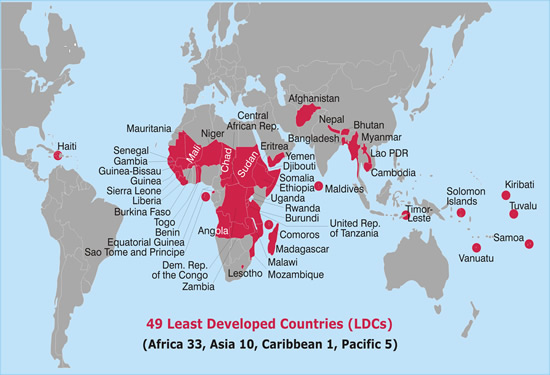| EMBARGO The contents of this press release and the related Report must not be quoted or summarized in the print, broadcast or electronic media before 16 July 2009, 17:00 [GMT] (1pm New York; 19:00 Geneva) |
Forty-nine countries currently are designated by the United Nations as "least developed countries" (LDCs). They are distributed among the following regions:
- Africa (33): Angola, Benin, Burkina Faso, Burundi, Central African Republic, Chad, Comoros, Democratic Republic of the Congo, Djibouti, Equatorial Guinea, Eritrea, Ethiopia, Gambia, Guinea, Guinea-Bissau, Lesotho, Liberia, Madagascar, Malawi, Mali, Mauritania, Mozambique, Niger, Rwanda, Sao Tome and Principe, Senegal, Sierra Leone, Somalia, Sudan, Togo, Uganda, United Republic of Tanzania and Zambia;
- Asia (10): Afghanistan, Bangladesh, Bhutan, Cambodia, Lao People´s Democratic Republic, Maldives, Myanmar, Nepal, Timor-Leste and Yemen;
- Pacific (5): Kiribati, Samoa, Solomon Islands, Tuvalu and Vanuatu;
- Caribbean (1): Haiti.
Establishing the LDC list
The list of LDCs is reviewed every three years by the Economic and Social Council (ECOSOC) of the United Nations based on recommendations by the Committee for Development Policy (CDP).
For its Mach 2009 review of the list, the CDP determined that a country may be designated as an LDC if it meets the following three criteria:
- A "low-income" criterion, based on the gross national income (GNI) per capita (a 3-year average), with thresholds of US$905 for cases of addition to the list;
- A "human assets weakness" criterion based on a composite index (the Human Assets Index) which consists of indicators on nutrition, health, school enrolment and literacy;
- An "economic vulnerability" criterion based on a composite index (the Economic Vulnerability Index) which includes indicators on natural shocks, trade shocks; exposure to shocks, economic smallness, and economic remoteness.
For all three criteria, different thresholds are used for addition to and graduation from the list of LDCs. A country will qualify to be added to the list of LDCs if it meets addition thresholds on all three criteria and does not have a population greater than 75 million. A country will normally qualify for graduation from LDC status if it has met graduation thresholds under at least two of the three criteria in at least two consecutive triennial reviews of the list. However, if the GNI per capita of an LDC has risen to a level at least double the graduation threshold, the country will be deemed eligible for graduation regardless of its performance under the other two criteria.
Only two countries have so far graduated from the list of LDCs: Botswana in December 1994, and Cape Verde in December 2007. Samoa is expected to graduate in December 2010, and Maldives in January 2011. The CDP in 2009 recommended that Equatorial Guinea be graduated from the list of LDCs.
ANNEX
Tables and figures
Figure 1 - 49 Least Developed Countries (LDCs)
Source: UNCTAD
| Overview in English [33 pages, 1220 KB]
| Overview in French [37 pages, 494 KB]
| Overview in Spanish [37 pages, 290 KB]
| Overview in Arabic [38 pages, 396 KB]
| Overview in Russian [48 pages, 360 KB]
| Overview in Chinese [33 pages, 420 KB]|


